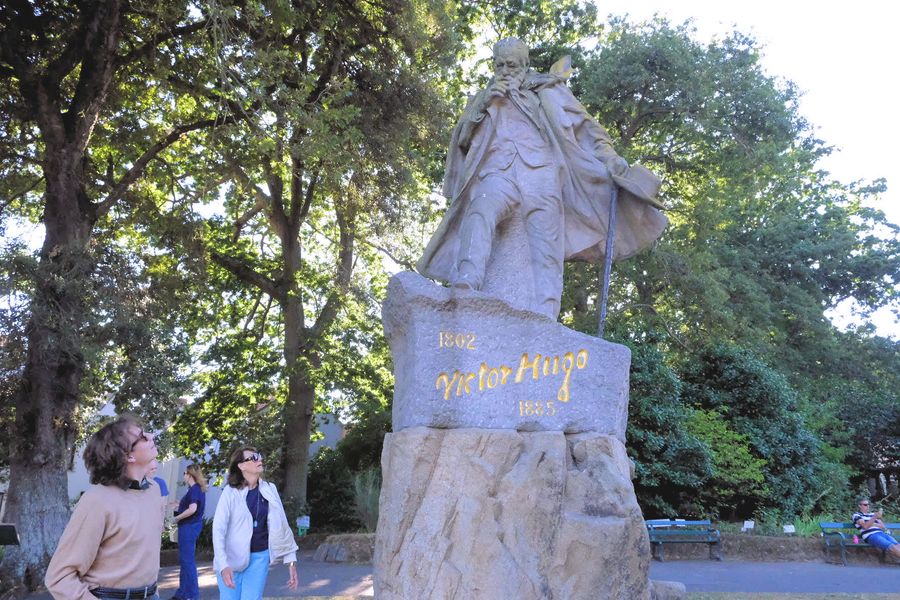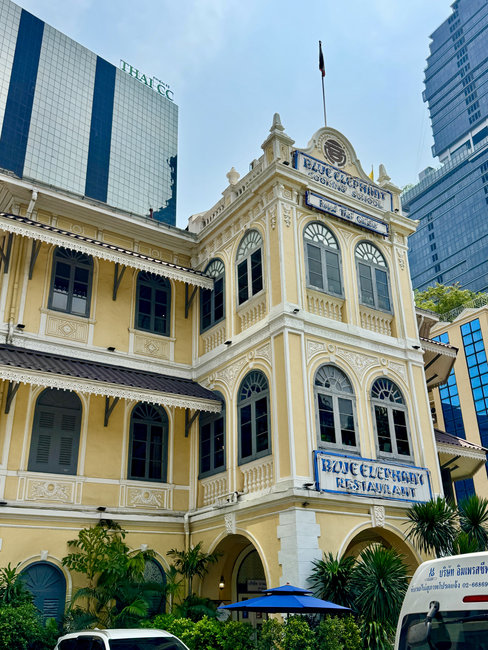A VISIT TO “HAUTEVILLE HOUSE” IN GUERNSEY WHERE VICTOR HUGO LIVED IN EXILE FOR 15 YEARS AND WROTE “LES MISERABLES.”

Marla and I wanted to show our grandson Paxton “Hauteville House” where Victor Hugo lived for 15 years (1855 – 1870) in exile after he was banished from France due to the coup d’etat by Louis Napoleon Bonaparte. The day before we walked by the Victor Hugo statue in Candie Gardens. The statue, by Jean Boucher in 1913, was a gift from the French government for the Guernsey hospitality afforded Victor Hugo. The inscription on the back reads, “AU ROCHER D’HOPITALITE ET DE LIBERTE A CE COIN DE VEILLE TERRE NORMANDIE OU VIT LE NOBLE PETITE PEUPLE DE LA MER A L’ILE DE GUERNSEY, SEVERE ET DOUCE”
‘To the rock of hospitality and liberty, to that portion of old Norman ground inhabited by the noble little nation of the sea. To the island of Guernsey, severe yet gentle…’
This is a wonderful video of Victor Hugo’s life on the island.

My sister Patty and husband Vic took us on a tour of Hauteville House on our very first trip to Guernsey many years ago.

Marla and Paxton walk up Hauteville Street from town. We reserved for a tour in advance. The house was previously closed during an 18-month-long, 4.5-million-euro restoration, primarily underwritten by French industrialist François Pinault’s private art initiative, the Pinault Collection.

Hauteville House remained in the family until 1927, when it was donated to the City of Paris by Victor Hugo’s granddaughter, Jeanne Negreponte, and the children of his grandson Georges Hugo, on the occasion of the centenary of the Romantic Movement.
Many masterpieces were written here – Les Misérables, Toilers of the Sea, The Man Who Laughs, The Legend of the Ages, Le Théâtre en Liberté, etc. – and the house is also a work of art by its layout and décor, designed by Victor Hugo himself.

The house is built on 4 floors, topped with a belvedere and overlooks the old town of Saint Peter Port and Havelet Bay. Entirely furnished and decorated by the poet, the house and its contents reflect Hugo’s creative genius during his time in exile. The house which, in the words of Charles Hugo, is an “autograph on three floors and a poem in several rooms,” is a work of art in its own right, immersing visitors in a unique atmosphere. Some of the walls and doors are made from pieces of old chests.

Dishes on the wall in the ground floor.

We were fortunate to have a wonderful guide. This is the billiard room on the ground floor.

A portrait of Victor Hugo and his son, Francois-Victor.

The Tapestry Room.


Victor Hugo’s creative design genius is on display with the furniture made of old oak chests. Tapestries are on the walls and pieced together on the ceilings.

Hugo had an affinity for chinoiserie elements which are throughout the home.

Our guide tells the history of the dining room.

Delft tiles on the fireplace.

Victor Hugo covered the ceilings with old woodcarving and tapestries. Carved words are expressed above the fireplace.

Stairs to the first floor.

The “Salon Rouge” is breathtaking! Fabulous fabrics and embroideries are used throughout. During the renovation the French fabric house Pierre Frey found in its archives a swatch of the original crimson silk damask used on the walls and reproduced a near-identical textile, while Maison Lesage restored the embroidered silk panels on the Red Room’s doors. Zuber et Cie replaced the long-faded floral Chinese Scenery paper painstakingly produced entirely by hand—that Hugo had mounted on the walls and ceiling of the vestibule.

I really love the assemblage of styles and decoration.

Chinoiserie fabric on the lambrequin and doors.

The Oak Room.


Third floor terrace with views of St. Peter Port and Castle Cornet.

Up the staircase to the Lookout.

The Lookout is where Victor Hugo wrote many of his masterpieces and his many letters.

Paxton takes photos in the garden.
To say Victor Hugo was a man of many facets is a total understatement. He was of course the famous author of works which resonate strongly to this day. He was also a political activist, a supporter of the poor and downtrodden, women’s rights, a playwright and poet, an artist, and even a spiritualist.
His devoted mistress came to live in Guernsey as well and lived…just down the street. The story of Juliette Drouet is an amazing story in itself and worthy of a novel or film. Click on these links for more of her amazing story: The devoted life of Juliette Drouet. And Part 1… and Part 2.
Photos: Dick Gentry. Not to be used without permission.
About The Author
admin
Related Posts
BANGKOK ADVENTURES…VISITING A SIMPLY GORGEOUS RESTAURANT, MARLA AND LISA DANCING ON STAGE, AND THE MOST UNUSUAL SHOPPING CENTER I’VE EVER SEEN.
Our Bangkok explorations continue with a simply superb lunch at the beautiful Blue Elephant Restaurant…
September 30, 2022VISITING OUR GOOD FRIEND LINDA IN BEAUTIFUL BRAZIERS END, CHOLESBURY, ENGLAND
After our little holiday on the island of Guernsey we flew back to England and…
September 30, 2022

Leave A Comment